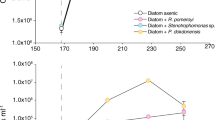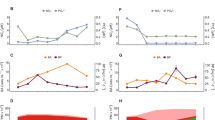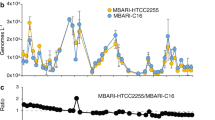Abstract
Resolving the ecological niches of coexisting marine microbial taxa is challenging due to the high species richness of microbial communities and the apparent functional redundancy in bacterial genomes and metagenomes. Here, we generated over 11 million Illumina reads of protein-encoding transcripts collected from well-mixed southeastern US coastal waters to characterize gene expression patterns distinguishing the ecological roles of hundreds of microbial taxa sharing the same environment. The taxa with highest in situ growth rates (based on relative abundance of ribosomal protein transcripts) were typically not the greatest contributors to community transcription, suggesting strong top-down ecological control, and their diverse transcriptomes indicated roles as metabolic generalists. The taxa with low in situ growth rates typically had low diversity transcriptomes dominated by specialized metabolisms. By identifying protein-encoding genes with atypically high expression for their level of conservation, unique functional roles of community members emerged related to substrate use (such as complex carbohydrates, fatty acids, methanesulfonate, taurine, tartrate, ectoine), alternative energy-conservation strategies (proteorhodopsin, AAnP, V-type pyrophosphatases, sulfur oxidation, hydrogen oxidation) and mechanisms for negotiating a heterogeneous environment (flagellar motility, gliding motility, adhesion strategies). On average, the heterotrophic bacterioplankton dedicated 7% of their transcriptomes to obtaining energy by non-heterotrophic means. This deep sequencing of a coastal bacterioplankton transcriptome provides the most highly resolved view of bacterioplankton niche dimensions yet available, uncovering a spectrum of unrecognized ecological strategies.
Similar content being viewed by others
Log in or create a free account to read this content
Gain free access to this article, as well as selected content from this journal and more on nature.com
or
References
Allers E, Gómez-Consarnau L, Pinhassi J, Gasol J, Simek K, Pernthaler J . (2007). Response of Alteromonadaceae and Rhodobacteriaceae to glucose and phosphorus manipulation in marine mesocosms. Environ Microbiol 9: 2417–2429.
Béjà O, Aravind L, Koonin E, Suzuki M, Hadd A, Nguyen L . et al (2000). Bacterial rhodopsin: Evidence for a new type of phototrophy in the sea. Science 289: 1902–1906.
Cai WJ . (2011). Estuarine and coastal ocean carbon paradox: CO2 sinks or sites of terrestrial carbon incineration? Annu Rev Mar Sci 3: 123–145.
Campbell BJ, Yu L, Heidelberg JF, Kirchman DL . (2011). Activity of abundant and rare bacteria in a coastal ocean. Proc Natl Acad Sci USA 108: 12776–12781.
Cho JC, Vergin KL, Morris RM, Giovannoni SJ . (2004). Lentisphaera araneosa gen. nov., sp. nov., a transparent exopolymer producing marine bacterium, and the description of a novel bacterial phylum, Lentisphaerae. Environ Microbiol 6: 611–621.
Coleman ML, Sullivan MB, Martiny AC, Steglich C, Barry K, Delong EF . et al (2006). Genomic islands and the ecology and evolution of Prochlorococcus. Science 311: 1768–1770.
Cunliffe M . (2011). Correlating carbon monoxide oxidation with cox genes in the abundant Marine Roseobacter Clade. ISME J 5: 685–691.
Cursino L, Li Y, Zaini PA, De La Fuente L, Hoch HC, Burr TJ . (2009). Twitching motility and biofilm formation are associated with tonB1 in Xylella fastidiosa. FEMS Microbiol Lett 299: 193–199.
del Giorgio PA, Cole JJ . (1998). Bacterial growth efficiency in natural aquatic systems. Annu Rev Ecol Syst 29: 503–541.
Dufrene M, Legendre P . (1997). Species assemblages and indicator species: the need for a flexible asymmetrical approach. Ecol Monogr 67: 345–366.
Eisen MB, Spellman PT, Brown PO, Botstein D . (1998). Cluster analysis and display of genome-wide expression patterns. Proc Natl Acad Sci USA 95: 14863–14868.
Ferrera I, Gasol JM, Sebastian M, Hojerova E, Koblizek M . (2011). Comparison of growth rates of aerobic anoxygenic phototrophic bacteria and other bacterioplankton groups in coastal Mediterranean waters. Appl Environ Microbiol 77: 7451–7458.
Fraiberg M, Borovok I, Bayer EA, Weiner RM, Lamed R . (2011). Cadherin domains in the polysaccharide-degrading marine bacterium Saccharophagus degradans 2-40 are carbohydrate-binding modules. J Bacteriol 193: 283–285.
Fraiberg M, Borovok I, Weiner RM, Lamed R . (2010). Discovery and characterization of cadherin domains in Saccharophagus degradans 2-40. J Bacteriol 192: 1066–1074.
Frias-Lopez J, Shi Y, Tyson GW, Coleman ML, Schuster SC, Chisholm SW . et al (2008). Microbial community gene expression in ocean surface waters. Proc Natl Acad Sci USA 105: 3805–3810.
Fuhrman JA, Hewson I, Schwalbach MS, Steele JA, Brown MV, Naeem S . (2006). Annually reoccurring bacterial communities are predictable from ocean conditions. Proc Natl Acad Sci USA 103: 13104–13109.
García-Contreras R, Celis H, Romer I . (2004). Importance of Rhodospirillum rubrum H+-pyrophosphatase under low-energy conditions. J Bacteriol 186: 6651–6655.
Gifford SM, Sharma S, Rinta-Kanto J, Moran MA . (2011). Quantitative analysis of a deeply sequenced marine microbial metatranscriptome. ISME J 5: 461–472.
Hardin G . (1960). Competitive exclusion principle. Science 131: 1292–1297.
Hendrickson L, Liu Y, Rosas-Sandoval G, Porat I, Soll D, Whitman WB . et al (2008). Global responses of Methanococcus maripaludis to specific nutrient limitations and growth rate. J Bacteriol 190: 2198–2205.
Hewson I, Poretsky RS, Dyhrman ST, Zielinski B, White AE, Tripp HJ . et al (2009). Microbial community gene expression within colonies of the diazotroph, Trichodesmium, from the Southwest Pacific Ocean. ISME J 3: 1286–1300.
Hollibaugh J, Gifford SM, Sharma S, Bano N, Moran MA . (2011). Metatranscriptomic analysis of ammonia-oxidizing organisms in an estuarine bacterioplankton assemblage. ISME J 5: 866–878.
Hutchinson GE . (1961). The paradox of the plankton. Am Nat 95: 137–145.
Jamshad M, De Marco P, Pacheco CC, Hanczar T, Murrell JC . (2006). Identification, mutagenesis, and transcriptional analysis of the methanesulfonate transport operon of Methylosulfonomonas methylovora. Appl Environ Microbiol 72: 276–283.
Kelly DP, Murrell JC . (1999). Microbial metabolism of methanesulfonic acid. Arch Microbiol 172: 341–348.
Kimura H, Young CR, Martinez A, Delong EF . (2011). Light-induced transcriptional responses associated with proteorhodopsin-enhanced growth in a marine flavobacterium. ISME J 5: 1641–1651.
Lauro FM, McDougald D, Thomas T, Williams T, Egan S, Rice S . et al (2009). The genomic basis of trophic strategy in marine bacteria. Proc Natl Acad Sci USA 106: 15527–15533.
Lecher J, Pittelkow M, Zobel S, Bursy J, Bonig T, Smits SHJ . et al (2009). The crystal structure of UehA in complex with ectoine - A comparison with other TRAP-T binding proteins. J Mol Biol 389: 58–73.
Maguire BA . (2009). Inhibition of bacterial ribosome assembly: a suitable drug target? Microbiol Mol Biol Rev 73: 22–35.
Malik R, Viola RE . (2010). Structural characterization of tartrate dehydrogenase: a versatile enzyme catalyzing multiple reactions. Acta Crystallogr D 66: 673–684.
Malmstrom RR, Cottrell MT, Elifantz H, Kirchman DL . (2005). Biomass production and assimilation of dissolved organic matter by SAR11 bacteria in the northwest Atlantic ocean. Appl Environ Microbiol 71: 2979.
Marsh ME, Chang DK, King GC . (1992). Isolation and characterization of a novel acidic polysaccharide containing tartrate and glyoxylate residues from the mineralized scales of a unicellular coccolithophorid alga Pleurochrysis carterae. J Biol Chem 267: 20507–20512.
Meyer B, Kuever J . (2007). Molecular analysis of the distribution and phylogeny of dissimilatory adenosine-59-phosphosulfate reductase-encoding genes (aprBA) among sulfur-oxidizing prokaryotes. Microbiology 153: 3478–3498.
Moran MA, Buchan A, Gonzalez JM, Heidelberg JF, Whitman WB, Kiene RP . et al (2004). Genome sequence of Silicibacter pomeroyi reveals adaptations to the marine environment. Nature 432: 910–913.
Moran MA . (2008). Genomics and metagenomics of marine prokaryotes. In: Kirchman (ed), Microbial Ecology of the Oceans, 2nd edn. Wiley-Liss: New York, NY.
Mou XZ, Sun SL, Edwards RA, Hodson RE, Moran MA . (2008). Bacterial carbon processing by generalist species in the coastal ocean. Nature 451: 708–711.
Mulligan C, Fischer M, Thomas GH . (2011). Tripartite ATP-independent periplasmic (TRAP) transporters in bacteria and archaea. FEMS Microbiol Rev 35: 68–86.
Pielou E . (1966). The measurement of diversity in different types of biological collections. J Theor Biol 13: 131–144.
Polz MF, Hunt DE, Preheim SP, Weinreich DM . (2006). Patterns and mechanisms of genetic and phenotypic differentiation in marine microbes. Philos Trans R Soc B 361: 2009–2021.
Pomeroy LJ, Wiegert RG (ed) (1981) The Ecology of a Salt Marsh. Springer: New York, NY.
Poretsky RS, Bano N, Buchan A, LeCleir G, Kleikemper J, Pickering M . et al (2005). Analysis of microbial gene transcripts in environmental samples. Appl Environ Microbiol 71: 4121–4126.
Poretsky RS, Gifford SM, Rinta-Kanto J, Vila-Costa M, Moran MA . (2009). Analyzing gene expression from marine microbial communities using environmental transcriptomics. J Vis Exp 24: pii.1086.
Poretsky RS, Sun S, Mou X, Moran MA . (2010). Transporter genes expressed by coastal bacterioplankton in response to dissolved organic carbon. Environ Microbiol 12: 616–627.
Rinta-Kanto JM, Sun S, Sharma S, Kiene RP, Moran MA . (2012). Bacterial community transcription patterns during a marine phytoplankton bloom. Environ Microbiol 14: 228–239.
Schauer K, Rodionov DA, de Reuse H . (2008). New substrates for TonB-dependent transport: do we only see the 'tip of the iceberg'? Trends Biochem Sci 33: 330–338.
Sowell SM, Abraham PE, Shah M, Verberkmoes NC, Smith DP, Barofsky DF . et al (2011). Environmental proteomics of microbial plankton in a highly productive coastal upwelling system. ISME J 5: 856–865.
Stewart FJ, Sharma AK, Bryant JA, Eppley JM, DeLong EF . (2011). Community transcriptomics reveals universal patterns of protein sequence conservation in natural microbial communities. Genome Biol 12: R26.
Suttle CA . (2007). Marine viruses - major players in the global ecosystem. Nat Rev Microbiol 5: 801–812.
Teira E, Martinez-Garcia S, Lonberg C, Alvarez-Salgado XA . (2009). Growth rates of different phylogenetic bacterioplankton groups in a coastal upwelling system. Environ Microbiol Rep 1: 545–554.
Thrash JC, Cho JC, Vergin KL, Morris RM, Giovannoni SJ . (2010). Genome sequence of Lentisphaera araneosa HTCC2155(T), the type species of the order Lentisphaerales in the phylum Lentisphaerae. J Bacteriol 192: 2938–2939.
Tripp HJ, Kitner JB, Schwalbach MS, Dacey JWH, Wilhelm LJ, Giovannoni SJ . (2008). SAR11 marine bacteria require exogenous reduced sulphur for growth. Nature 452: 741–744.
Tripp HJ, Schwalbach MS, Meyer MM, Kitner JB, Breaker RR, Giovannoni SJ . (2009). Unique glycine-activated riboswitch linked to glycine-serine auxotrophy in SAR11. Environ Microbiol 11: 230–238.
Urakawa H, Martens-Habbena W, Stahl DA . (2011). Physiology and genomics of ammonia-oxidizing Archaea. In: Ward BB, Arp DJ, Klotz MG (eds.) Nitrification. ASM Press: Washington, DC.
Van Mooy BAS, Fredricks HF, Pedler BE, Dyhrman ST, Karl DM, Koblizek M . et al (2009). Phytoplankton in the ocean use non-phosphorus lipids in response to phosphorus scarcity. Nature 458: 69–72.
Van Mooy BAS, Rocap G, Fredricks HF, Evans CT, Devol AH . (2006). Sulfolipids dramatically decrease phosphorus demand by picocyanobacteria in oligotrophic marine environments. Proc Natl Acad Sci USA 103: 8607–8612.
Wei Y, Lee JM, Richmond C, Blattner FR, Rafalski JA, LaRossa RA . (2001). High-density microarray-mediated gene expression profiling of Escherichia coli. J Bacteriol 183: 545–556.
Wilson DN, Nierhaus KH . (2007). The weird and wonderful world of bacterial ribosome regulation. Crit Rev Biochem Mol Biol 42: 187–219.
Worden AZ, Seidel M, Smriga S, Wick A, Malfatti F, Bartlett D . et al (2006). Trophic regulation of Vibrio cholerae in coastal marine waters. Environ Microbiol 8: 21–29.
Woyke T, Xie G, Copeland A, González JM, Han C, Kiss H . et al (2009). Assembling the marine metagenome, one cell at a time. PLoS One 4: e5299.
Yokokawa T, Nagata T, Cottrell MT, Kirchman DL . (2004). Growth rate of the major phylogenetic bacterial groups in the Delaware estuary. Limnol Oceanogr 49: 1620–1629.
Yooseph S, Nealson KH, Rusch DB, McCrow JP, Dupont CL, Kim M . et al (2010). Genomic and functional adaptation in surface ocean planktonic prokaryotes. Nature 468: 60–66.
Acknowledgements
We thank S Holland for helpful discussions on statistical methods and M Moore, L Griffin, B Durham and R Newton for assisting in sample collection. We also thank the three anonymous reviewers for their insightful and productive comments. This project was supported by funding from the Gordon and Betty Moore Foundation and the National Science Foundation Microbial Observatories Program (MCB-0702125).
Author information
Authors and Affiliations
Corresponding author
Additional information
Supplementary Information accompanies the paper on The ISME Journal website
Supplementary information
Rights and permissions
About this article
Cite this article
Gifford, S., Sharma, S., Booth, M. et al. Expression patterns reveal niche diversification in a marine microbial assemblage. ISME J 7, 281–298 (2013). https://doi.org/10.1038/ismej.2012.96
Received:
Revised:
Accepted:
Published:
Issue date:
DOI: https://doi.org/10.1038/ismej.2012.96
Keywords
This article is cited by
-
Seasonal patterns in microbial carbon and iron transporter expression in the Southern Ocean
Microbiome (2023)
-
Proteomic traits vary across taxa in a coastal Antarctic phytoplankton bloom
The ISME Journal (2022)
-
The ecological responses of bacterioplankton during a Phaeocystis globosa bloom in Beibu Gulf, China highlighted by integrated metagenomics and metatranscriptomics
Marine Biology (2022)
-
Microbial metabolites in the marine carbon cycle
Nature Microbiology (2022)
-
Microbial iron and carbon metabolism as revealed by taxonomy-specific functional diversity in the Southern Ocean
The ISME Journal (2021)



